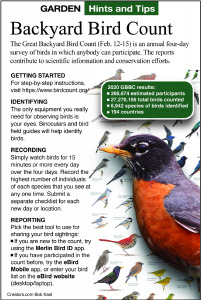Subscriber Benefit
As a subscriber you can listen to articles at work, in the car, or while you work out. Subscribe NowDuring the past year, we were often told to listen to or follow the science. Well, I am happy to report that there is more and more scientific evidence to support the idea that everyone would be better off watching birds. You can watch them at a feeder while you are sitting on the couch, or you can go to a park to see them.
Studies from England, Los Angeles and Spain indicate that the close

r you live to a park and the more contact you have with nature, the better your mood, psychological well-being, mental health and cognitive functioning scores will be. In short, watching birds is good for you, and you don’t even need a note from the doctor to do it. For those interested in the mental health aspects of birding, the book “Bird Therapy” by Joe Harkness will be helpful.
Because so many people stayed home this last year with nothing to do, many people started bird-watching. The sale of bird seed, feeders, houses and birdbaths helped bird-supply stores stay afloat. You can continue watching birds in the comfort of your home, but if you want to go to a park, bird-watching is easy to do while social distancing. In fact, being slightly farther apart helps people to talk less, which allows you to hear more birds. On the other hand, birding alone can be wonderful.
February is National Bird-Feeding Month, as noted by the National Bird-Feeding Society. If you want to feed birds, use one of the most preferred seeds: black-oil sunflower, sunflower chips, nyjer and white proso millet. Small finches, such as goldfinches and pine siskins, prefer sunflower chips and nyjer (also called thistle, even though it is not a thistle). Larger finches such as house finches, purple finches and cardinals prefer black-oil sunflower seed. White proso millet is preferred by ground-feeding birds such as doves, juncos and sparrows. Chickadee and nuthatch species that grab a seed from a bird feeder and fly away to eat it elsewhere prefer sunflower seeds.
There are seeds that are unattractive to birds. Red milo is a seed few birds will eat, unless all the other seeds are gone. Seed blends with large amounts of red milo will get knocked out of the feeder as the birds search for the seeds they prefer, making a mess and creating a weed problem.
Not only does science say you should watch birds, but you can also help scientists help the birds you are watching. Scientists can’t be everywhere, so you can be a scientist.
The Great Backyard Bird Count that the Cornel Lab of Ornithology operates will take place Feb. 12-15, and you can do it from the comfort of your living room if you want to. It is an annual four-day period when bird-watchers create a snapshot of where birds are across the continent. Anyone can be a bird-watcher for those four days. A “backyard” can be anywhere you happen to be — a schoolyard, a local park, the balcony of a high-rise apartment or a wildlife refuge.
Doing the count is easy. All you do is count the birds you see at your location. The highest number of each species seen on any of the days is recorded. Then you go to https://www.birdcount.org to record your list online. While you are there, check out the photo contest page to see some great photos.
By comparing the results from year to year, we all can learn migration patterns of birds and see long-term population trends and the year-to-year changes.
The Great Backyard Bird Count website can help you prepare for a trip to the backyard or wherever you choose to watch birds. The site is full of tips of all kinds, including information on bird identification apps for your phone.
The results of each Great Backyard Bird Count survey are displayed on a variety of maps. You can easily see the distribution pattern of any bird species. You can also see the same map change over time as the bird’s mapped distribution changes over the years. You can compare your sightings with everyone else’s in your state.
Email questions to Jeff Rugg at [email protected].
Please enable JavaScript to view this content.
